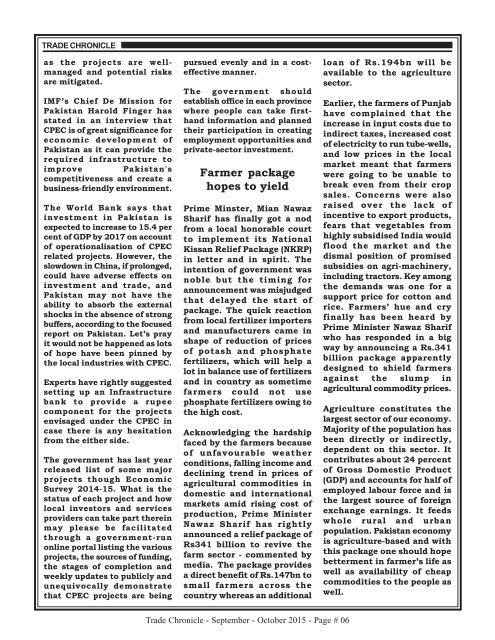Trade Chronicle Sep-Oct 2015
Create successful ePaper yourself
Turn your PDF publications into a flip-book with our unique Google optimized e-Paper software.
TRADE CHRONICLE<br />
as the projects are wellmanaged<br />
and potential risks<br />
are mitigated.<br />
IMF’s Chief De Mission for<br />
Pakistan Harold Finger has<br />
stated in an interview that<br />
CPEC is of great significance for<br />
economic development of<br />
Pakistan as it can provide the<br />
required infrastructure to<br />
improve<br />
Pakistan's<br />
competitiveness and create a<br />
business-friendly environment.<br />
The World Bank says that<br />
investment in Pakistan is<br />
expected to increase to 15.4 per<br />
cent of GDP by 2017 on account<br />
of operationalisation of CPEC<br />
related projects. However, the<br />
slowdown in China, if prolonged,<br />
could have adverse effects on<br />
investment and trade, and<br />
Pakistan may not have the<br />
ability to absorb the external<br />
shocks in the absence of strong<br />
buffers, according to the focused<br />
report on Pakistan. Let’s pray<br />
it would not be happened as lots<br />
of hope have been pinned by<br />
the local industries with CPEC.<br />
Experts have rightly suggested<br />
setting up an Infrastructure<br />
bank to provide a rupee<br />
component for the projects<br />
envisaged under the CPEC in<br />
case there is any hesitation<br />
from the either side.<br />
The government has last year<br />
released list of some major<br />
projects though Economic<br />
Survey 2014-15. What is the<br />
status of each project and how<br />
local investors and services<br />
providers can take part therein<br />
may please be facilitated<br />
through a government-run<br />
online portal listing the various<br />
projects, the sources of funding,<br />
the stages of completion and<br />
weekly updates to publicly and<br />
unequivocally demonstrate<br />
that CPEC projects are being<br />
pursued evenly and in a costeffective<br />
manner.<br />
The government should<br />
establish office in each province<br />
where people can take firsthand<br />
information and planned<br />
their participation in creating<br />
employment opportunities and<br />
private-sector investment.<br />
Farmer package<br />
hopes to yield<br />
Prime Minster, Mian Nawaz<br />
Sharif has finally got a nod<br />
from a local honorable court<br />
to implement its National<br />
Kissan Relief Package (NKRP)<br />
in letter and in spirit. The<br />
intention of government was<br />
noble but the timing for<br />
announcement was misjudged<br />
that delayed the start of<br />
package. The quick reaction<br />
from local fertilizer importers<br />
and manufacturers came in<br />
shape of reduction of prices<br />
of potash and phosphate<br />
fertilizers, which will help a<br />
lot in balance use of fertilizers<br />
and in country as sometime<br />
farmers could not use<br />
phosphate fertilizers owing to<br />
the high cost.<br />
Acknowledging the hardship<br />
faced by the farmers because<br />
of unfavourable weather<br />
conditions, falling income and<br />
declining trend in prices of<br />
agricultural commodities in<br />
domestic and international<br />
markets amid rising cost of<br />
production, Prime Minister<br />
Nawaz Sharif has rightly<br />
announced a relief package of<br />
Rs341 billion to revive the<br />
farm sector - commented by<br />
media. The package provides<br />
a direct benefit of Rs.147bn to<br />
small farmers across the<br />
country whereas an additional<br />
loan of Rs.194bn will be<br />
available to the agriculture<br />
sector.<br />
Earlier, the farmers of Punjab<br />
have complained that the<br />
increase in input costs due to<br />
indirect taxes, increased cost<br />
of electricity to run tube-wells,<br />
and low prices in the local<br />
market meant that farmers<br />
were going to be unable to<br />
break even from their crop<br />
sales. Concerns were also<br />
raised over the lack of<br />
incentive to export products,<br />
fears that vegetables from<br />
highly subsidised India would<br />
flood the market and the<br />
dismal position of promised<br />
subsidies on agri-machinery,<br />
including tractors. Key among<br />
the demands was one for a<br />
support price for cotton and<br />
rice. Farmers’ hue and cry<br />
finally has been heard by<br />
Prime Minister Nawaz Sharif<br />
who has responded in a big<br />
way by announcing a Rs.341<br />
billion package apparently<br />
designed to shield farmers<br />
against the slump in<br />
agricultural commodity prices.<br />
Agriculture constitutes the<br />
largest sector of our economy.<br />
Majority of the population has<br />
been directly or indirectly,<br />
dependent on this sector. It<br />
contributes about 24 percent<br />
of Gross Domestic Product<br />
(GDP) and accounts for half of<br />
employed labour force and is<br />
the largest source of foreign<br />
exchange earnings. It feeds<br />
whole rural and urban<br />
population. Pakistan economy<br />
is agriculture-based and with<br />
this package one should hope<br />
betterment in farmer’s life as<br />
well as availability of cheap<br />
commodities to the people as<br />
well.<br />
<strong>Trade</strong> <strong>Chronicle</strong> - <strong>Sep</strong>tember - <strong>Oct</strong>ober <strong>2015</strong> - Page # 06

















